This is Part 3 of a series of posts on the construction of a Pearl Harbor diorama. It will depict the Zeros of the Imperial Japanese Navy’s Akagi aircraft carrier preparing to take off during the first wave attack. To understand the concept of this diorama project, please refer to the previous posts. This post concerns only the nine Zero pilots who participated in the first wave. It’s important to make abundantly clear at the outset that I’m not an expert on this subject and what follows is superficial research compiled from the dozen books I own on the Zero, supplemented by bits and pieces from obscure corners of the internet.
I. Introduction
It is often stated that few of the highly skilled pilots of the Imperial Japanese Navy (IJN) at the beginning of the Pacific War — most of them highly experienced veterans of the China War — survived the conflict. While there is little doubt the assertion is generally accurate, information specifically summarizing the fate of IJN Pearl Harbor pilots proved elusive — at least in English. My interest, of course, was on the fate of the nine Akagi Zero pilots who participated in the first wave. Below is a June 1941 photo of Akagi’s fighter pilots from the new edition of Ikuhiko Hata et al’s Japanese Naval Fighter Aces 1932-45, translated from the Japanese by Christopher Shores.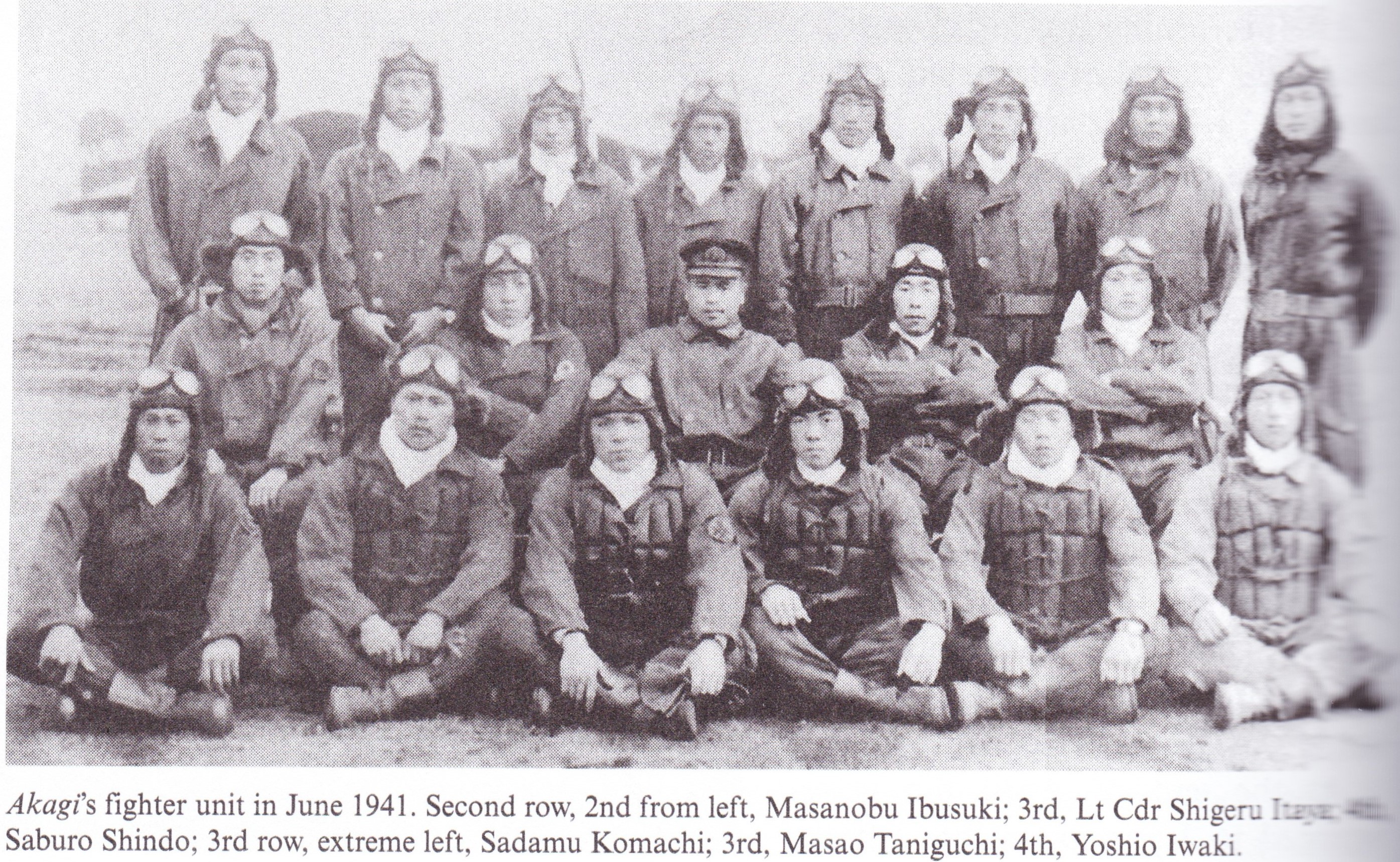 Conveniently for purposes of this post, Peter Smith’s Mitsubishi Zero: Japan’s Legendary Fighter provides a narrative that names all nine Akagi Zero pilots of the first wave:
Conveniently for purposes of this post, Peter Smith’s Mitsubishi Zero: Japan’s Legendary Fighter provides a narrative that names all nine Akagi Zero pilots of the first wave:
“The Akagi had contributed the No. 1 Fighter Strike Unit comprising a hikotai of nine A6M2s divided into three shotai of three planes each. No. 1 Shotai was Lieutenant-Commander Shigeru Itaya, who was in overall command of the 1st Wave fighter aircraft, with Petty Officers 1st Class Takashi Hirano and Shinatsugu Iwama. No. 2 Shotai consisted of Lieutenant Masanobu Ibusuki, with Petty Officer 1st Class Yoshio Iwashiro and Seaman 1st Class Toichiro Hanyu. No. 3 Shotai comprised Warrant Officer Suekichi Osanai, Petty Officer 2nd Class Masao Yaguchi and Seaman 1st Class Mitsuyoshi Takasuka.”
Curiously, Smith does not provide a similar narrative for the pilots of Akagi’s second wave, nor does he provide any narrative whatsoever for the pilots of the other five aircraft carriers at Pearl Harbor. A rare and serendipitous occurrence, it’s as if Smith knew that these were the nine names I needed. 
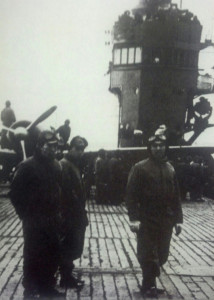 At any rate, once armed with the names of the nine pilots, obtaining additional information was simply a matter of checking indices, lists of aces, lists of deaths, and lists of academy graduates in other books, plus bits and pieces from the internet.
At any rate, once armed with the names of the nine pilots, obtaining additional information was simply a matter of checking indices, lists of aces, lists of deaths, and lists of academy graduates in other books, plus bits and pieces from the internet.
Notations
Two notations are necessary at this point. First, the spelling of Japanese names can often get mangled in translation. Thus, for consistency I’ve used the spelling in Hata et al’s Japanese Naval Fighter Aces 1932-45. For example, after several searches proved futile, I concluded that the following corrections were necessary to Peter Smith’s list: Shinatsugu Iwama was actually Shinaji Iwama; Yoshio Iwashiro was actually Yoshio Iwaki; Masao Yaguchi was actually Masao Taniguchi; and Mitsuyoshi Takasuka was actually Mitsuyoshi Takasuga.
Secondly, I thought it best to avoid using ranks after Pearl Harbor to avoid confusion, as pilots were promoted over the course of the war and it was not uncommon to promote pilots posthumously. For example, a pilot may have held the rank of seaman during Pearl Harbor but had been promoted to petty officer at the time of his death.
II. The Pilots: Low Odds of Survival
Below is a table of the Zeros that participated in Akagi’s first wave used in a previous post, modified to include the pilots’ names and the date of their deaths (DOD). I used various sources, most notably the aforementioned new edition of Hata et al’s Japanese Naval Fighter Aces 1932-45, which helpfully includes a couple of profiles of the Zeros used by these pilots.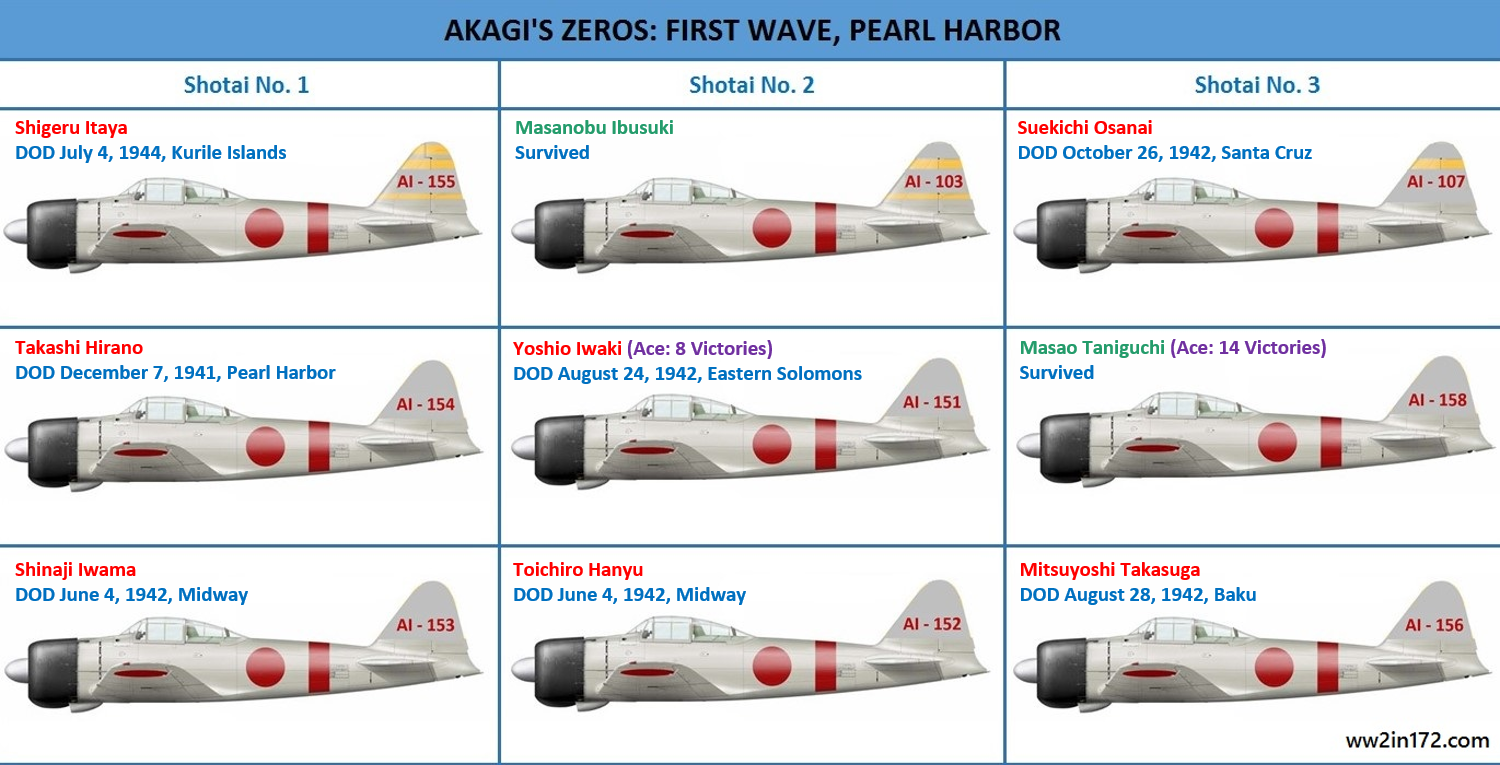 Though the Japanese pilots who participated in the Pearl Harbor attack were considered some of the most experienced, most highly skilled, best trained pilots in the world at the outbreak of the Pacific War, the odds of surviving the war were minimal, irrespective of experience, skill, or training. It is a sobering thought that, as the table graphically demonstrates, of the nine Akagi Zero pilots who participated in the first wave, six had perished by October 1942 — less than a year after Pearl Harbor — and another was killed by the end of the war. Only two of the nine pilots survived the war. While this sample size is too small to extrapolate to the 78 Zero pilots from all six carriers in both waves, it does provides a reasonable estimate of the number of survivors: probably around 17.
Though the Japanese pilots who participated in the Pearl Harbor attack were considered some of the most experienced, most highly skilled, best trained pilots in the world at the outbreak of the Pacific War, the odds of surviving the war were minimal, irrespective of experience, skill, or training. It is a sobering thought that, as the table graphically demonstrates, of the nine Akagi Zero pilots who participated in the first wave, six had perished by October 1942 — less than a year after Pearl Harbor — and another was killed by the end of the war. Only two of the nine pilots survived the war. While this sample size is too small to extrapolate to the 78 Zero pilots from all six carriers in both waves, it does provides a reasonable estimate of the number of survivors: probably around 17.
The table also makes clear just how difficult it was to make ace; i.e., to score five victories. As can be seen on the table, only two of the nine pilots accomplished the feat, one with 14 victories and one with 8 victories, despite the fact that these were some of the most experienced pilots in the world involved in arguably the most target-rich episode in human history. Thus, the odds of making ace were the same as those of surviving the war — roughly one in five. (NB: Let’s be clear, “victory” is a euphemism for “kill,” the term more commonly used. To be an “ace,” a pilot had to shoot down five enemy planes, which often resulted in killing five or more men. I use the term “ace” without any value judgment. These men were merely doing what their country asked of them. To the extent there’s admiration for an “ace,” it is not because the pilot killed other men but rather because of the skill necessary to survive.)
III. Notable Pilots
While I’m fairly certain that much could be written about each one of these nine pilots, my goal was to identify them and their Zeros and ascertain whether they survived the war or made ace. I hope the table above achieves that modest purpose. However, I want to bring the reader’s attention to four of these pilots, without disrespect or attempt to diminish the achievements or sacrifices of the other five. These four pilots are pictured below; from left to right, they are Shigeru Itaya, Yoshio Iwaki, Masao Taniguchi, and Masanobu Ibusuki. Uncannily, all four appear in the first photo above and are specifically identified in the caption, despite the fact that only six of the 19 pilots pictured are mentioned in the caption.
Shigeru Itaya, the overall commander of the 43 Zeros in the first wave, was covered in a previous post, soon to be rewritten with assistance received from readers familiar with Japanese sources. Please refer to that post by clicking here. Yoshio Iwaki, one of the two pilots who made ace, had earned eight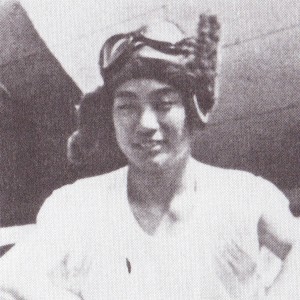 victories when he met his death August 24, 1942, in the Eastern Solomons, incidentally serving on the Shokaku — another carrier present at Pearl Harbor.
victories when he met his death August 24, 1942, in the Eastern Solomons, incidentally serving on the Shokaku — another carrier present at Pearl Harbor.
The other ace was Masao Taniguchi, pictured in the lagniappe photo at left, who not only has the distinction of achieving the most victories — 14 — but was also one of the two pilots who survived the war. After being shot down in October 1944, he was fortunate to be convalescing in Japan when the war came to an end. Coincidentally, Taniguchi, like Iwaki, also served on the Shokaku after the Akagi was sunk at Midway.
Because Iwaki and Taniguchi both made ace, information on them is slightly more available. See, for example, Hata et al’s Japanese Naval Fighter Aces for short biographies of these two. However, it was Masanobu Ibusuki, the other pilot who survived the war, and for whom little information is available, whose story I found compelling — and the subject of the next post.
As always, thank you for your indulgence and I hope you enjoyed the post. If something looks amiss, please let me know. I would be delighted to correct inaccurate information so that this may be useful to other 1/72 scale collectors and wargamers. As always, comments, questions, corrections, and observations are welcome. As mentioned, stay tuned for a brief biographic note on Masanobu Ibusuki in the next post.

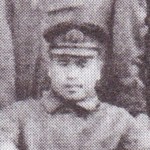
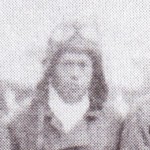
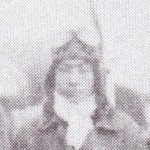
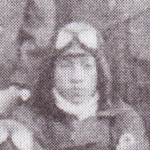
Ara says:
Waiting for the next exciting update!
Ara says:
I know I’m going to come back to these articles again and again when it’s time for me to get serious with my Witty Zeros. Thanks again chules for getting this info together. You make the hard stuff easy to visualize, so well written and in one place.
Ara says:
Chules, another excellent analysis that I read when you posted it in July. I visit your site to keep up with the Akagi Zero studies. Great work on the name drift and your corrections. This is all very interesting to those of us who like to look deep into shards of facts. You are doing a fine job of connecting the information, and presenting your findings graphically and with words. I will be visiting often, thank you for the posts!